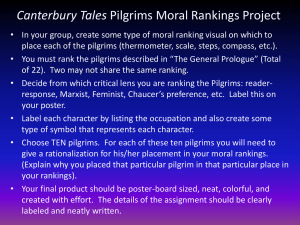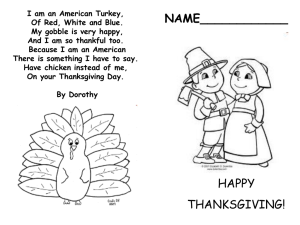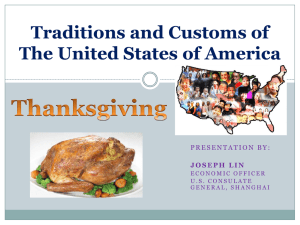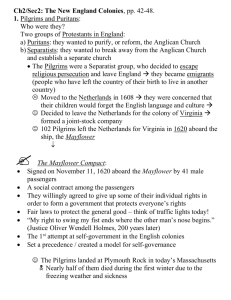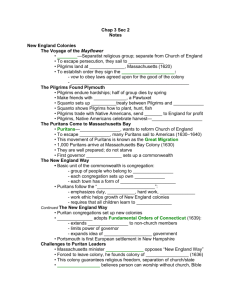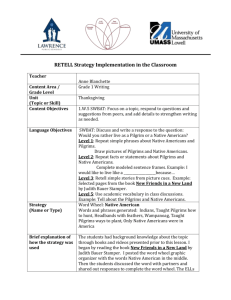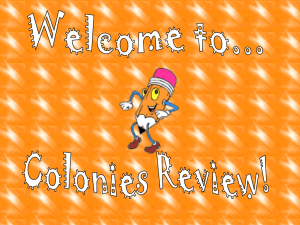Lesson Plan
advertisement
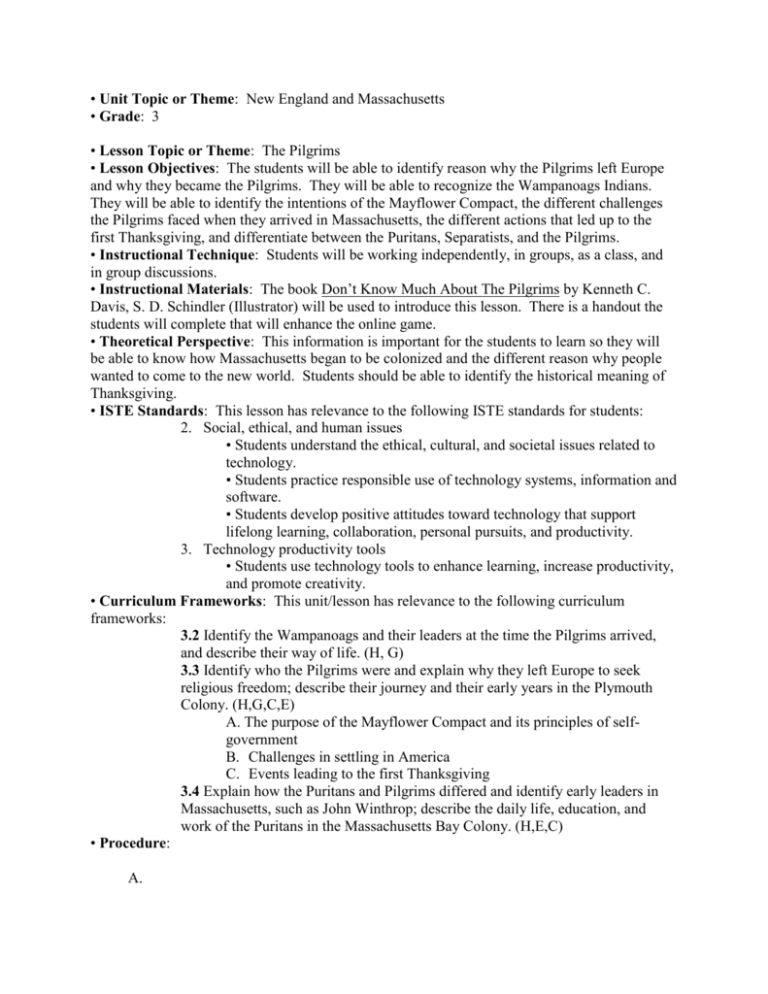
• Unit Topic or Theme: New England and Massachusetts • Grade: 3 • Lesson Topic or Theme: The Pilgrims • Lesson Objectives: The students will be able to identify reason why the Pilgrims left Europe and why they became the Pilgrims. They will be able to recognize the Wampanoags Indians. They will be able to identify the intentions of the Mayflower Compact, the different challenges the Pilgrims faced when they arrived in Massachusetts, the different actions that led up to the first Thanksgiving, and differentiate between the Puritans, Separatists, and the Pilgrims. • Instructional Technique: Students will be working independently, in groups, as a class, and in group discussions. • Instructional Materials: The book Don’t Know Much About The Pilgrims by Kenneth C. Davis, S. D. Schindler (Illustrator) will be used to introduce this lesson. There is a handout the students will complete that will enhance the online game. • Theoretical Perspective: This information is important for the students to learn so they will be able to know how Massachusetts began to be colonized and the different reason why people wanted to come to the new world. Students should be able to identify the historical meaning of Thanksgiving. • ISTE Standards: This lesson has relevance to the following ISTE standards for students: 2. Social, ethical, and human issues • Students understand the ethical, cultural, and societal issues related to technology. • Students practice responsible use of technology systems, information and software. • Students develop positive attitudes toward technology that support lifelong learning, collaboration, personal pursuits, and productivity. 3. Technology productivity tools • Students use technology tools to enhance learning, increase productivity, and promote creativity. • Curriculum Frameworks: This unit/lesson has relevance to the following curriculum frameworks: 3.2 Identify the Wampanoags and their leaders at the time the Pilgrims arrived, and describe their way of life. (H, G) 3.3 Identify who the Pilgrims were and explain why they left Europe to seek religious freedom; describe their journey and their early years in the Plymouth Colony. (H,G,C,E) A. The purpose of the Mayflower Compact and its principles of selfgovernment B. Challenges in settling in America C. Events leading to the first Thanksgiving 3.4 Explain how the Puritans and Pilgrims differed and identify early leaders in Massachusetts, such as John Winthrop; describe the daily life, education, and work of the Puritans in the Massachusetts Bay Colony. (H,E,C) • Procedure: A. 1. To introduce the specific topic of the Pilgrims, students, as a class, will be read the book Don’t Know Much About the Pilgrims by Kenneth C. Davis, S.D. Schindler (Illustrator). B. 2. Students will then in small groups talk about things they know, any things they specifically want to learn, and things they have heard about the Pilgrims. 3. One person from every group will report to the class what they know, what they want to learn, or a question they have. This should lead to a small discussion. 4. Students will pair up and work on the interactive game about the Pilgrims. They must read the fact and the question, then choose the answer they think is correct. 5. While working on the game, students will work on a worksheet that will lead to a short discussion and will help the students compare or relate different aspect of the Pilgrims journey to their own lives. 6. If students do not have enough time to finish in one class, they will be able to write down which question they left off on and will be able to start from that spot on the next class. C. 7. To sum up the lesson, students will, as a class, discuss the things they wrote on the worksheet. D. Students who struggle with reading will be paired with a student who is ahead in reading. The student who is struggling will follow along as the other student reads aloud. Students who have trouble writing will be able to discuss the questions on the worksheet aloud and report as a group. Also there are vocabulary words highlighted in red that will lead them to the vocabulary page that will help all students. E. There will not be any homework assigned to this specific lesson. • Evaluation: A. The students will take a test at the end of the unit to demonstrate what they have learned.


